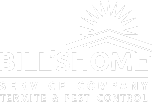
Bill’s Home Service
251 W. Duval Road, Green Valley, AZ 85614
PMD License #4320, BTR License #15619
Office: 520-625-2381
This year, in celebration of our 60th anniversary, Bill’s Home Service is sharing the spotlight with 60 Southern Arizona pests.
Follow Bill’s Home Service on social media to participate in our “Name that Pest” game where we leave it up to you to guess the correct pest. The answers will be revealed here. Happy guessing!